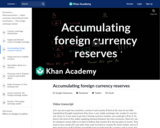
How and why a central bank would build foreign currency reserves. Created by Sal Khan.
- Subject:
- Economics
- Social Science
- Material Type:
- Lesson
- Provider:
- Khan Academy
- Provider Set:
- Khan Academy
- Author:
- Sal Khan
- Date Added:
- 07/27/2021

How and why a central bank would build foreign currency reserves. Created by Sal Khan.
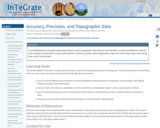
This jigsaw style exercise challenges new geomorphology students to collect topographic data and analyze its accuracy and precision.
(Note: this resource was added to OER Commons as part of a batch upload of over 2,200 records. If you notice an issue with the quality of the metadata, please let us know by using the 'report' button and we will flag it for consideration.)
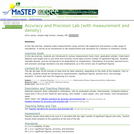
In this lab exercise, students practice correctly using measurement tools, recording data, calculating density, using significant figures, and exploring the concepts of accuracy and precision.
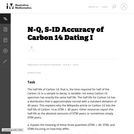
This task examines, from a mathematical and statistical point of view, how scientists measure the age of organic materials by measuring the ratio of Carbon 14 to Carbon 12. The focus here is on the statistical nature of such dating. This task addresses a very important issue about precision in reporting and understanding statements in a realistic scientific context.
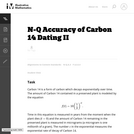
This task is a refinement of ``Carbon 14 dating'' which focuses on accuracy. Because radioactive decay is an atomic process modeled by the laws of quantum mechanics, it is not possible to know with certainty when half of a given quantity of Carbon 14 atoms will decay. This type of question is very important in science and it also provides an opportunity to study the very subtle question of how errors behave when applying a function: in some cases the errors can be magnified while in others they are lessened.

This lesson explains how to accurately read a graduate that are used in healthcare settings. This presentation introduces some beginning concepts on what is out put and what is the signficance of accurately measuring it when providing care. Then the lesson continues into explaining how to accurately read 3 different types of graduates in ounces, ml, and cubic centimeters. Then provides three practice problems with answers provided.

This problem involves solving a system of algebraic equations from a context: depending how the problem is interpreted, there may be one equation or two.

This task is a somewhat more complicated version of "Accurately weighing pennies I'' as a third equation is needed in order to solve part (a) explicitly. Instead, students have to combine the algebraic techniques with some additional problem-solving (numerical reasoning, informed guess-and-check, etc.)

Ce module vise à renforcer les compétences des étudiants de licence 3 à l’analyse des défis et enjeux urbains dans les pays en développement. Il met l’accent sur les études de cas à Ouagadougou (Burkina Faso), Bamako (Mali) Accra (Ghana) et Maputo (Mozambique).
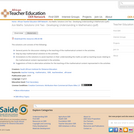
The solutions unit consists of the following: General points for discussion relating to the teaching of the mathematical content in the activities. Step-by-step mathematical solutions to the activities. Annotations to the solutions to assist teachers in their understanding the maths as well as teaching issues relating to the mathematical content represented in the activities. Suggestions of links to alternative activities for the teaching of the mathematical content represented in the activities.
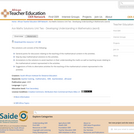
The solutions unit consists of the following: General points for discussion relating to the teaching of the mathematical content in the activities. Step-by-step mathematical solutions to the activities. Annotations to the solutions to assist teachers in their understanding the maths as well as teaching issues relating to the mathematical content represented in the activities. Suggestions of links to alternative activities for the teaching of the mathematical content represented in the activities
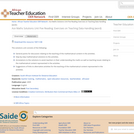
The solutions unit consists of the following: General points for discussion relating to the teaching of the mathematical content in the activities. Step-by-step mathematical solutions to the activities. Annotations to the solutions to assist teachers in their understanding the maths as well as teaching issues relating to the mathematical content represented in the activities. Suggestions of links to alternative activities for the teaching of the mathematical content represented in the activities.
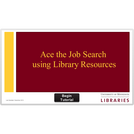
Learn how to research companies, industries and other critical business information to give you an edge in the job search process with this interactive tutorial.
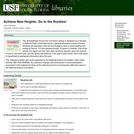
Spreadsheets Across the Curriculum module/Geology of National Parks course. Students estimate travel times and costs of a driving/camping trip to visit national parks in Colorado.

Word Count: 4017
(Note: This resource's metadata has been created automatically by reformatting and/or combining the information that the author initially provided as part of a bulk import process.)
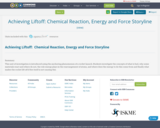
This unit of investigation is introduced using the anchoring phenomenon of a rocket launch. Students investigate the concepts of what is fuel, why some materials react and others do not, the role energy plays in the rearrangement of atoms, and where does the energy to do this come from and finally what makes the rocket lift off if fire itself is not causing this.
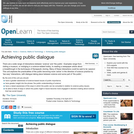
There are a wide range of interactions between 'science' and 'the public'. Examples range from visiting a museum, or indulging in a science-related hobby, to reading a newspaper article about a breakthrough in the techniques of therapeutic cloning. Many of these interactions could be said to be 'passive'. This unit explores the practicalities of the public becoming more 'active' in the direction of science practice by 'two-way' interactions, with dialogue taking place between science and some part of 'the public',
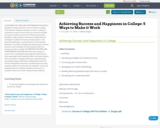
ACHIEVING SUCCESS AND HAPPINESS IN COLLEGE is designed to help students to be successful in college. This includes students who plan to enter a college or university, as well as those who are currently enrolled and want to make the most of it! This book provides insights to help students understand college life and strategies to address the most pressing issues—the personal challenges, social pressures, and academic demands. It includes thought-provoking quotes, humor, honesty, and techniques for becoming an effective learner as well as a leader.
ACHIEVING SUCCESS AND HAPPINESS IN COLLEGE describes how to play an active role in creating learning opportunities that are both meaningful and inspiring, which can help students down the path to a happy, productive, and personally rewarding college experience. Additionally, this book will be of significant interest to professionals who help students achieve success from an academic, social, and health perspective. Family members will see it as a valuable resource for their college-bound children.
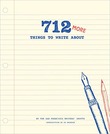
This lesson is about teaching about how to write paragraphs in cursive, and also topic in cursive. for example (favorite movie, class, book, or health goal.)

This resource is a video abstract of a research paper created by Research Square on behalf of its authors. It provides a synopsis that's easy to understand, and can be used to introduce the topics it covers to students, researchers, and the general public. The video's transcript is also provided in full, with a portion provided below for preview:
"The Isthmus of Tehuantepec in Mexico is one of the windiest places on earth making it a hotspot for investment in wind energy. But that’s proving problematic. Because although wind-energy investments appear to be paving the way toward a sustainable future a new study reports that a lack of good governance is proving unsustainable for the large indigenous population that calls the Isthmus home. Mexico is among the many nations that have implemented policies supporting the Sustainable Development Goals established by the United Nations. a blueprint for achieving a sustainable future for our planet. But in the Isthmus of Tehuantepec, these efforts do not adequately include local indigenous communities. It’s a problem caused by a combination of corruption, poor accountability, and limited access to information about energy and the environment. Fortunately, paths for reversing these poor governance patterns do appear to exist..."
The rest of the transcript, along with a link to the research itself, is available on the resource itself.